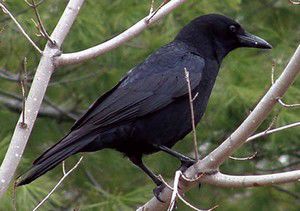Nature Notes: Something to crow about
Published 5:00 pm Tuesday, May 11, 2004

- <I>CRAIG SPARKS photo</I><BR>Avoid feeding crows; they play havoc with other Peninsula birds.
Different groupings of animals often have unique and interesting names, and that’s never more true than with our wild birds.
From lofty names such as an “exaltation” of larks, a “parliament” of owls or even an “ostentation” of domestic peacocks, to a simple “charm” of finches. But our favorite is and always has been, a “murder” of crows.
Crows are generally considered to be the most intelligent of our local wild birds, and when it comes to crows living in close company with humans, that which is good about them may also be that which is bad about them.
The crow population here on the coast has exploded in the last few years. With fewer and fewer predators left to help control their numbers, combined with their fantastic ability to adapt to changing conditions, the future would seem to be crow heavy.
The iridescent green-black shine of their feathers, big dark all-seeing eyes combined with their daring attitude and curious nature, make crows very likable. As a result, many people feed them in backyard feeders with food scraps. Well-meaning folks simply feeding hungry crows. No big deal, right?
Well, here’s the scoop. Crows, by their very nature, prey on almost all species of nesting songbirds, hummingbirds, upper tree canopy birds, and also waterfowl and shorebirds.
We have, just in the last few years, for example, seen mama crows teaching young crows the fine points of how to separate momma duck or goose from their babies in order to get a meal. This has been very uncommon in the past, but seems to be on the increase.
The same holds true for gull chicks and a whole host of seabirds. The crows have become the de facto top predator. The result of this huge crow population is a decrease in the songbird and shorebird numbers.
Crows are extremely interesting animals to watch, and they are the true definition of the word omnivore. That is, they will and can eat just about anything, from road kill carrion to bread crumbs, and from baby ducks to seagull eggs. In fact, few young birds are safe from crows.
Let’s remember that the problem is not with the crows, but rather the sheer number of crows. With declining habitat, and state and county coffers drained, there is little incentive or interest to protect the habitat of our wild bird populations. So the always successful crows will continue to have the upper hand if we keep feeding them and helping them increase their numbers.
Some tips:
Crows are not particularly early risers, so if you need to put out feed for your songbirds or waterfowl, put it out in the evening, as songbirds feed much earlier than crows and they will find the food sooner. Also, don’t put out more food than your little birds can eat at any one time, as excess food just invites the crows in to feed.
If you place birdhouse/nesting boxes out, the success rate for songbirds improves dramatically because the crows have a harder time raiding a bird box than an open branch nest.
These are a few things we can do to help with the crow imbalance, and at the end of the day, we like chickadees just the same as crows just the same as seagulls.
Check out our new weekly nature movie at: (http://home.pacifier.com/~sparks/wildlife!!.html)
Craig Sparks is director of NAWA, a filmmaker, freelance writer and wildlife rehabilitator.
Found injured wildlife? Questions? Call the Wildlife Center at 665-3595 or send an e-mail to: sparks@pacifier.com.
High quality photo reprints from Nature Notes can be found online at: www.chinookobserver.info.









